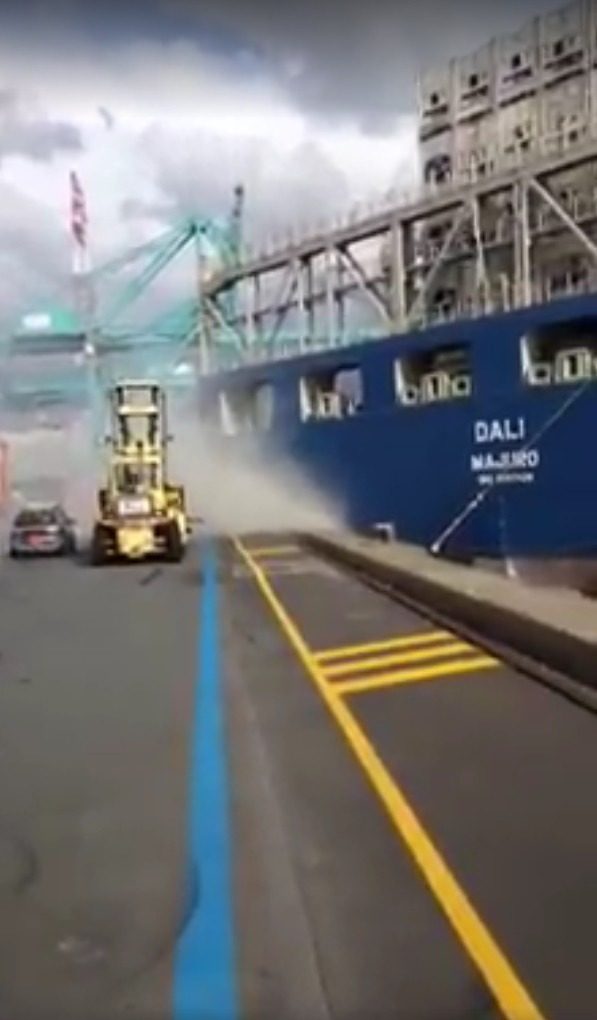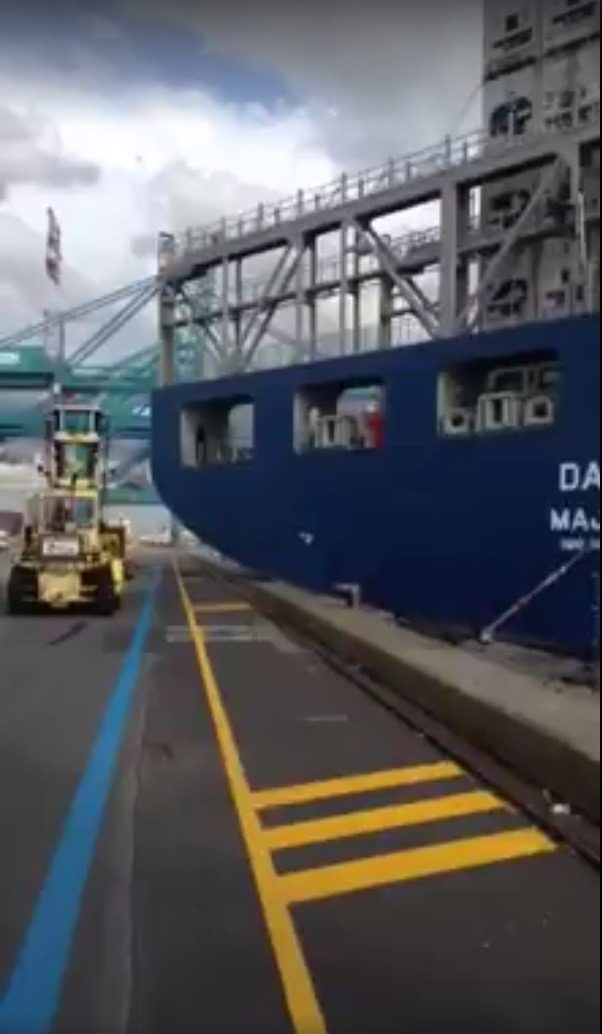“The Baltimore Francis Scott Key Bridge take-down was a trillion-dollar costly event, ongoing, and yet all culpable persons remain unnamed, kept totally anonymous, with some reportedly having been slyly ‘escaped’ from the country! There is, in fact, zero publicly-verifiable evidence that any genuine Captain, Pilots or Crew ever existed: Was DALI a remote-controlled ghost-ship on kamikazee mission from its outset? No waves or creaking metal nor splash-down sounds at all were recorded nor (initially) noted by any (reportedly) nearby persons; cameras recorded zero shaking, seismometers measured zero vibration. Anomalies and oddities galore overwhelm the aftermath, beguile reason, confound explanation. No interviews exist with supposed survivors; “family and friends” etc interviews reveal ‘dupers-delight’ micro-facial-expressions with other hallmarks suggestive of fraud. No verifications of any supposed deaths have yet been publicized. Rampant is the extremely suspicious damage with blatantly visible, verifiable anomalies (including massive, five-storys tall fireballs in both original night-time videos) totally inexplicable (and wholly ignored) by official theory or story. Grand payola galore is already underway with loads more coming. This event appears to involve another shabby yet audacious crime, militarized from gov to salvage to rebuild. There was no rescue skiff on scene as required by OSHA. No horn blasts from ship warned of imminent collision. The DALI ship departed despite (supposed) dire electrical problems, illegal at any time and even more highly unusual in the cold, dark night-time (part #94, first ‘after-sundown departure’ in two years). It goes on and on and on. Criminal was this manufactured event, through and through, and that’s before considering the absurd number of other anomalies ignored by the complicit, owned, ‘kept-pet’ mass-media…”
Part #91 adapted from a video comment.
Don’t miss the apparent precursor Tampa Bay Sunshine Skyway Bridge take-down test-run in 1981.
Index . Oddity List . Official Story . Summary
DALI Previous Crash
In 2016 —
“The mega container ship Dali allided with berth at Port of Antwerp during unmooring maneuvers for leaving the port. The incident happened in good weather and was caused by mistake of the Master and pilot on board.
“The container carrier had substantial stern momentum, which caused allision with the stone wall of the quay. Following the incident, the vessel Dali suffered sufficient damages in the stern and transom. The container ship remained afloat, but has some breaches near the waterline and will need of repairs. The berth was also seriously damaged and closed for cargo handling operations due to safety reasons.
“The container ship Dali was detained and docked to Deurganckdok, Antwerp, where will be repaired and fully inspected before released to return in operations. The vessel will have some delay from the time schedule. Fortunately during the accident there were no injured people and water pollution.
“Dali (IMO: 9697428) has overall length of 300.00 m, moulded beam of 48.00 m and maximum draft of 11.00 m. The deadweight of the carrier is 111,032 DWT and the gross tonnage is 94,730 GRT. The vessel was built in 2015 by Hyundai Heavy Industries in South Korean. The owner of the container ship Dali Greek company Oceanbulk Maritime, but currently vessel is chartered by Maersk Line.”
IMO:9697428
MMSI:563004200
Callsign:9V5283
Width:48.0 m
Length:300.0 m
AIS type: Cargo Ship
Flag: Singapore
Gross tonnage: 95128 (tons) — 95,000 tons times 2,000 pounds (per ton) makes the ship’s weight up to 190,256,000 — over 190 million pounds.
Accelerating 190 million pounts to 8 knots speed from a standstill at dock not even 6 miles away is basically impossible. Someone is lying about the speed or omitting other information.
see also https://www.vesseltracker.com/en/Ships/Dali-9697428.html


DALI Ownership Details
Direct Link to Remote Control Technologies
The boat owner SYNGERY group in Singapore is claimed to be led by someone having interest in remote control systems.
January 2022, the CEO of Synergy Group, a global ship management company based in Singapore, was Rajesh Unni.
Rajesh Unni, the CEO of Synergy Group, has a background primarily in the shipping and maritime industry, focusing on ship management and related services. While there is no specific information readily available about his history or interest in remote control technologies and high-technology outside of the maritime sector, it’s worth noting that the shipping industry has been increasingly incorporating advanced technologies, including remote monitoring and control systems, to improve efficiency, safety, and sustainability.
Given Rajesh Unni’s leadership role in Synergy Group, which is involved in managing a fleet of ships, it’s possible that he has a keen interest in leveraging technological advancements, including remote control technologies, to enhance the company’s operations and services. However, without specific information or public statements from Rajesh Unni himself regarding his involvement or interest in high-technology sectors beyond maritime applications, it’s challenging to provide detailed insights into his history or specific interests in this area.
The Intriguing Tale of the Dali Allision and Synergy Group’s Remote Control Technology
Introduction
In maritime terminology, an “allision” refers to the event when a moving vessel strikes a stationary object, such as a bridge, pier, or another ship that is moored. Unlike a collision, which involves two moving vessels, an allision underscores the interaction between a single moving entity and an immovable one. This distinction is essential when dissecting the events surrounding the Dali ship and its dramatic allision in the Port of Antwerp.
The Dali Allision in Antwerp Port
The Dali, a cargo ship owned by Singapore’s Synergy Group, recently made headlines for a perplexing incident in the Port of Antwerp. The vessel, during its navigation through the port, made a direct, front-on impact with a support pillar of the Francis Scott Key Bridge. What made this incident particularly curious was the nature of the ship’s approach—described by some as “missile-like”—and the series of power outages that reportedly affected the ship’s propulsion, navigation, and guidance systems just before the impact.
Synergy Group’s Foray into Remote Control Technology
Synergy Group, known primarily for its shipping and logistics operations, has been making significant strides in the development of remote control technology. This innovation is aimed at revolutionizing maritime operations by enhancing safety, efficiency, and precision in ship navigation. Remote control systems allow for the management of a vessel’s operations from a remote location, potentially reducing human error and increasing operational efficiency.
Conspiratorial Claims and Intrigue
The incident involving the Dali in Baltimore at the Francis Scott Key Bridge has sparked a wave of conspiracy theories, particularly due to the vessel’s seemingly precise navigation despite the reported power outages. Skeptics argue that such a precise and forceful impact would be impossible without some form of external control or intervention, given the multiple system failures that supposedly occurred.
Several points fuel these conspiratorial claims:
- Perfect Navigation Amidst Power Outages: The Dali managed to navigate perfectly to make a direct impact on the bridge support pillar, a feat that would be difficult even under optimal conditions, let alone during simultaneous system failures.
- Synergy Group’s Remote Control Capabilities: The company’s investment and development in remote control technology add a layer of intrigue. Critics suggest that the technology could have been utilized, either deliberately or through a hacking incident, to guide the ship to its unfortunate destination.
- Missile-like Impact: Descriptions of the Dali’s approach to the bridge support pillar as “missile-like” raise questions about the nature of the ship’s final movements. This precise targeting implies a level of control and accuracy that seems incongruent with the reported system malfunctions.
Conclusion
While the exact cause of the Dali allisions in Antwerp Port (and also Baltimore Francis Scott Key Bridge South Pillar) remain under investigation, the involvement of Synergy Group and its advanced remote control technology development casts a shadow of intrigue over the incidents. In Baltimore, the suspiciously “perfect missile-like bullseye hit on the support pillar” navigation despite multiple power outages, coupled with the company’s capabilities, gives rise to speculative theories about potential external influences or technological malfeasance. As more details emerge, the maritime community and conspiracy theorists alike will be closely watching to unravel the mysteries surrounding this enigmatic event.